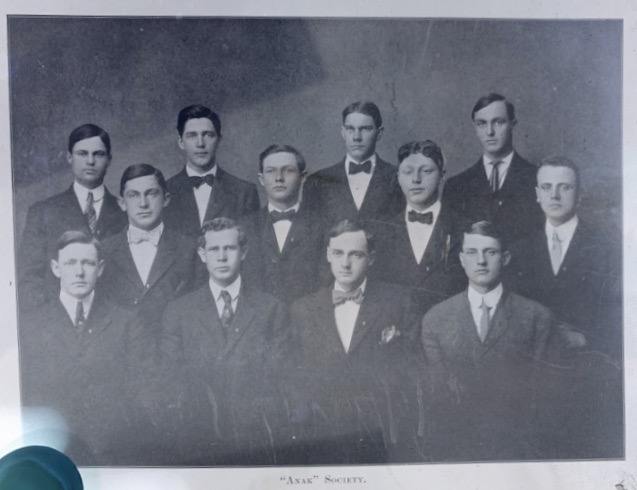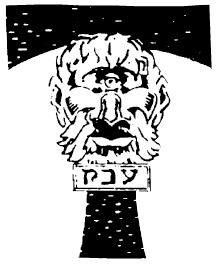The ANAK Society was founded on January 1, 1908 by four Georgia Tech seniors: George Wyman McCarty, Jr. (President), Harry Read Vaughan (Vice President), Lewis Edward Goodier, Jr. (Secretary) and Charles Atwater Sweet, Jr. (Treasurer). Other charter members (all seniors) were G. A. Hendrie, C. A. Adamson, S. J. Hargrove, J. E. Davenport, L. W. Robert, W. R. Snyder, Cherry L. Emerson and G. W. Holmes Cheney. In the 1909 Blue Print, the society described its purpose as follows:
“[The ANAK Society] is composed of men from the Senior Class of Georgia Tech who have shown themselves zealous in the development of college spirit. This organization is not here, primarily, as a social club or honorary society, but to do all it can to develop a better morale among the student body and improve all phases of college life.”
 Founding members of the ANAK Society circa 1908.
Founding members of the ANAK Society circa 1908.As the society's membership base grew, its influence and prestige likewise increased. By 1940, the ANAK Society was referred to as "the oldest honorary organization on the Tech campus" and membership as "the highest local honor a Tech student may obtain." These claims would generally go unchallenged throughout the rest of the century. Faculty recognition by the society, first initiated with the ANAK Award in 1942, would reach an equivalent level of prestige by the end of the century.
The ANAK Society played a major role in establishing several of Georgia Tech's most active student organizations, including two student publications and the student government. The society's existence was formally announced in the first edition of the Blue Print, Georgia Tech's yearbook, in 1908. Four ANAK charter members served on the first Blue Print editorial board. By 1911, ANAK admitted four more 1908 Blue Print editors into the society, including Editor-in-Chief John G. Chapman. These close relationships enabled the society to assert a great deal of control over the yearbook's direction in future decades. Along with several other clubs and societies, ANAK listed its membership roster and provided a group photograph in the yearbook.
Following the Blue Print, ANAK, along with three Georgia Tech faculty members, appointed the first staff of the Technique, Georgia Tech's student newspaper. The Technique published its first edition on November 11, 1911, and has been in continuous weekly publication since that time, with a modern circulation of 10,000.
In the absence of an official student government during the first few decades at Georgia Tech, the ANAK society acted as an unofficial student government and proposed an Honor Code, modeled on that of West Point's, in 1908. ANAK would work to set up a more formal organization, the Student Council (later the Student Government Association), in 1922, at which point it relinquished any decision-making privileges it had over the student body. Other student organizations ANAK played a role in establishing include a chapter of the YMCA in 1910 and the Ramblin' Reck Club in 1930.
For many years following the ANAK Society's founding, membership was not confidential. For example, membership rosters and group photos were annually published in the yearly Blue Print yearbook. ANAK members would select new initiates by "tapping" them (tapping them on the shoulder) at Georgia Tech's semi-annual Interfraternity Council (IFC) dance. The ritual was dropped in 1961 when ANAK elected to become a secret society. From this point forward, ANAK membership was made public only upon a student's graduation, via a list of graduating ANAK members published in the Technique each year and the ANAK Society's home page. A similar policy applies to faculty and honorary members, whose involvement with the society is only made known upon their retirement from Georgia Tech.
.jpeg) Georgia Tech's first three African American students, 1961.
Georgia Tech's first three African American students, 1961.The transition to secrecy was essential to support racial integration at Tech in the ealry 1960's. Beginning in the early 1920s, the ANAK Society involved itself in a number of civil rights activities. In 1921, ANAK spearheaded an effort to prevent the Ku Klux Klan from setting up a chapter at Georgia Tech. Around 1960, ANAK held a series of secret dinner meetings with the families of Ford Greene, Ralph A. Long, Jr. and Lawrence Michael Williams, Georgia Tech's first three African American students. The goal of these meetings, facilitated through the Georgia Tech YMCA that ANAK had established a half-century earlier, was to discuss the range of potential situations that could arise when the three students enrolled at Georgia Tech the following year, as well as appropriate reactions to each of these situations. When Greene, Long, and Williams enrolled in the fall semester of 1961, ANAK members discreetly kept a close watch on the three students for the first two weeks to ensure their safety.
Among the important events and achievements in the Society’s history are:
|
Founding of the ANAK Society; the creation of the first Honor Code system; and the start of Georgia Tech’s yearbook, the Blueprint. |
|
|
The pulling of the YMCA out of its dark days. |
|
|
The first discussion of the publishing of a school newspaper on October 5, 1911. The first issue was published the day before the Georgia game of 1911. The name chosen was the Technique, and the first two editors were E. A. Turner, the YMCA Secretary and Mrs. Bloom. Dr. Perry was the first faculty advisor and member of the staff. The other positions were filled by students. The Society and the three faculty members above picked the first staff. |
|
|
The movement for the correction of the medical conditions on the Tech campus, later leading to the building of the school hospital; creation of the Freshman Rat Cap system. |
|
|
The beginning of the movement for compulsory support of student publications. |
|
|
The merging of the two student publications, the old Yellow Jacket with the present Technique. The first, larger six-page paper later debuted on February 16, 1917. |
|
|
Organization and sponsorship of the first Tech Homecoming, held at the 1919 Commencement. |
|
|
Request of the formation of the first Publicity Bureau of the school. |
|
|
Fight against the Ku Klux Klan on the Tech campus. |
|
|
Formation of the Student Council, which later became the Student Government Association. |
|
|
The formation of the Yellow Jacket Club (now known as the Ramblin’ Reck Club). |
|
|
The changing of the Pass Book for 1932-33 and the publication of the Senior Personnel History for distribution to firms throughout the country to aid in the securing of positions for the senior class. |
|
|
First of present-day Homecoming celebrations sponsored by ANAK, ODK, and the Yellow Jacket Club. |
|
|
ANAK observes 50th anniversary. |
|
|
On November 15, Dr. Edward E. David (EE, ‘45) receives first annual George W. McCarty-ANAK award as “outstanding young alumnus of the year.” |
|
|
ANAK works behind the scenes to peacefully integrate Georgia Tech. |
|
|
A donation from J. Erskine Love begins the GT Student Foundation. |
|
|
Paul G. Mayer Garden by the Skiles Classroom Building is dedicated on May 30. |
|
|
The Mentor Program, matching students and alumni in common career interests, turned over to the Student Alumni Association. |
|
|
The second Honor Code established after Academic Senate approval and successful student referendum. |
|
|
TEAM Buzz, Tech’s campus-wide community service day, is started. |
|
|
When the Whistle Blows, the annual event to honor members of the Tech community who we have lost, is started. |
|
|
The swings by Woodruff and MRDC are constructed. |
